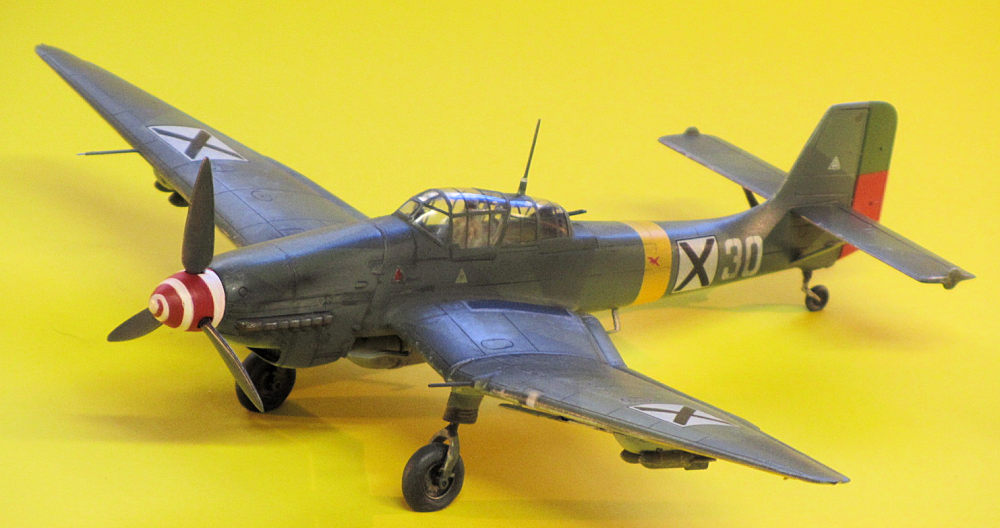
| KIT #: | F-16 |
| PRICE: | $15.00 'used' |
| DECALS: | Two options |
| REVIEWER: | Ryan Grosswiler |
| NOTES: |
LF Decals and Blackbird Productions unspatted landing gear |

| HISTORY |
You already know about this airplane: In the days before precision-guided munitions, the way you got air-dropped ordinance exactly on target was to dive your airplane straight down--keeping the bull's eye motionless in dead center in your windscreen--release the bomb, and pull up sharply before hitting the ground.
The Stuka (an abbreviation for the long German word literally translating into "dive-fight-airplane") was actually only one of many designed for this method of attack, but certainly the one which would become the most infamous for doing it. Distinctive for its primeval, predatory appearance, imparted by that inverted gull wing--cranked to give the main bomb load sufficient ground clearance--and a burly set of fixed, spatted landing gear, this aircraft was used on all fronts by all German European allies except Finland. Stukas made newsreels across a frightened world in the autumn of 1939, Stuka ketten peeling off one by one out of formation, rolling inverted, and diving straight down with those diabolical propeller-driven sirens wailing away and laying waste to traffic-jams of trucks and hordes of panicked enemy troops.
What you might not know is that the Stuka had to be fitted with
an autopilot to pull the aircraft out of that dive, following an incident in
which a Ju-87 squadron leader blacked out and impacted terrain, and his
entire kette following him, one after the other, right into the ground. This is
the first known use of an
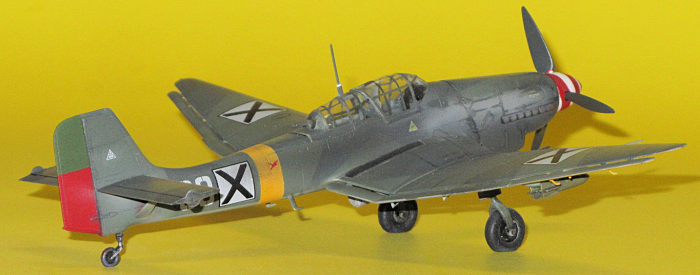 autopilot
feature for tactical weapons delivery (Twenty-seven
years later, the USAF would run into the same
approximate problem deploying its F-111 in Vietnam. Awesome as it was, the 111's
terrain-following radar-coupled autopilot could not adequately distinguish
between ridgelines and the trees which covered them. At least, that's what my
old boss who flew on that deployment told me!).
autopilot
feature for tactical weapons delivery (Twenty-seven
years later, the USAF would run into the same
approximate problem deploying its F-111 in Vietnam. Awesome as it was, the 111's
terrain-following radar-coupled autopilot could not adequately distinguish
between ridgelines and the trees which covered them. At least, that's what my
old boss who flew on that deployment told me!).
When forced to operate without guaranteed fighter cover over Britain in the summer of 1940, the Stuka's sluggish performance was exposed. Without a direct replacement in the pipeline, however, the Luftwaffe was forced to make do and added the bigger engine, a more refined cockpit canopy, and pointy wingtips to create the 'D' version modeled here. Endurance and weapons load were both significantly increased by the improvements, but basic performance remained unchanged and the aircraft had to operate until the end of the war dependent on significant air superiority overhead, or at night. This is true of all close air support aircraft since.
It was a captured example of this variant which famed Royal Navy test pilot Eric 'Winkle' Brown flew following the war, and issued a mixed review of the type: "...it gave the impression of being lot of airplane for one engine to pull...once settled down in cruise the feeling of vulnerability became almost oppressive, accentuated by the high position of the pilot's seat and the large glasshouse canopy." But he loved the aircraft's dive characteristics, stating, "maximum dive (for most dive bombers) is usually in the order of 60 degrees...(the Ju-87) is the only one you can truly dive vertically....for some indefinable reason it felt right, standing on its nose." And 'on its nose' is how the famous aircraft would be used in combat.
The Bulgarians and the Stuka:
Of all the combatants in the Second World War on either side, little Bulgaria probably had the loneliest war.
This old enemy of Constantinople was also one of the
world's first to establish an independent Air Force, in 1906. However, following
World War One, it found itself economically wrecked, geographically isolated,
deprived of territory, and its only friend found in traditional ally
Russia--but now mutated into the form of the newly-communist and hyperactively
revolution-exporting Soviet Union. A thinking, careful man, Tsar Boris worked to
build a hopeful future for his nation by establishing a "royal dictatorship" to
stabilize domestic unrest and sou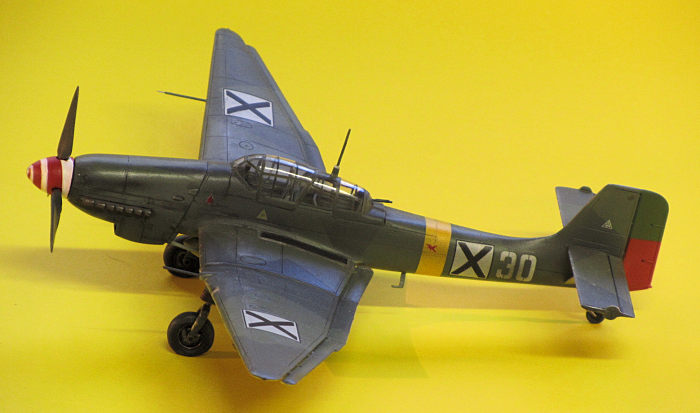 ght
in the late '30s to also regain Bulgaria's districts, Thrace and Macedonia, lost
in the aftermath of the Great War, without becoming embroiled in the larger
problem--the impending Second World War. Treading this dicey path, he shifted
alliance to Nazi Germany by signing the 1940 Tripartite Pact, declared war on
the US and UK, but declined Hitler's request to join the invasion of Russia and
even went a step further under the influence of his cabinet to protect the core
Jewish population of Bulgaria proper.
ght
in the late '30s to also regain Bulgaria's districts, Thrace and Macedonia, lost
in the aftermath of the Great War, without becoming embroiled in the larger
problem--the impending Second World War. Treading this dicey path, he shifted
alliance to Nazi Germany by signing the 1940 Tripartite Pact, declared war on
the US and UK, but declined Hitler's request to join the invasion of Russia and
even went a step further under the influence of his cabinet to protect the core
Jewish population of Bulgaria proper.
It was a logical strategy, but the way events unfolded, it
didn't work out. Hitler, fighting an increasing costly war in the USSR, became
angry with Boris' non-commitment to the Axis cause. Bulgarian forces moving in
to occupy in Thrace and Macedonia found foreigners living in their old homes
from 20 years earlier. The bitter reservists vented their frustrations on the
local newbies, and guerilla fighting broke out. Worse, Hitler badgered Boris to
help control the raucous Serbs in occupied Yugoslavia, attempting to get some
utility out of his ally, and by Boris' acquiescence further guerilla war was
opened. Turkey menaced as well, and more Bulgarian troops had to be sent to the
south. As if all this wasn't bad enough, the Western Allies vented their
feelings with a smattering of air raids on the country, becoming much worse in
late 1943 when capital city Sophia began suffering the attentions of the great
waves of USAAF B-24s shuttling to and from their bases in Africa to bomb Axis
oil fields in Romania as part of Operation Tidal Wave.
Thus, rather than a costly foreign war, Bulgaria was
rewarded with a costly domestic war--on all its borders and overhead! Besides
interceptors, it desperately needed effective counter-insurgency aircraft, and
the now-aloof Germans finally allowed them first a dozen obsolete Ju-87Rs for
training and then 40 Ju-87Ds, all secondhand from Luftwaffe stocks. These were
delivered in 1944, making Bulgaria the last recipient of the type, and ensuring
that the Bulgarian pilots finished their conversion training (from their
worn-out S.328s and PZL P.43s) just in time to turn on those who had trained
them.
Pushing the Axis inexorably back, the Soviets arrived at the Bulgarian border by September of 1944, and in a single week of panic there were three successive governments in Sophia, the Communist insurgents after a bloody uprising finally gaining full control and surrendering to the USSR. The predictable Bolshevik script of denunciations and abduction/execution followed, the military split in two, Bulgarian servicemen often having literally only seconds to figure out whose side they were on. The Soviets ordered their new ally into combat straight away against the Axis. A few Bulgarians fled to the Germans, including at least one Stuka crew with their airplane. The majority sided with the Communists, following the tried-and-true survival strategy of aligning oneself with those likely to remain in charge.
In Bulgarian service, the Ju-87 was therefore to primarily serve
in the long, bitter, westward fight alongside Soviet forces pursuing the Axis
all the way into Austria. In a weirdly anachronistic replay of the equipment
lineup of 1939, the Bulgarian Stukas went to work in immediately upon
declaration of war against Germany by supplementing Do-17s covered by Avia B-534
biplanes and French-made Dewoitine D.520s in attacks of Luftwaffe airfields.
With so much German/Western equipment, the Bulgarians and Soviets had to use
careful time-and-space separation tactics to prevent 'incidents'. But the USSR
was able to s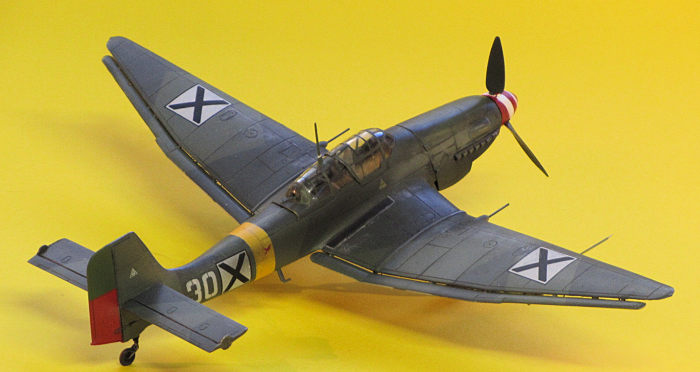 weep
the weakened Luftwaffe from the skies at this late stage, and the Bulgarians
were able to fight without threats from above.
weep
the weakened Luftwaffe from the skies at this late stage, and the Bulgarians
were able to fight without threats from above.
So--the Stuka ended its career in 1945 as it had begun six
years earlier: safe under an air-superiority umbrella,
Afterward, the Ju-87's technical non-supportability and cultural
association with the Nazis/Blitzkrieg assured
| THE KIT |
The Stuka, having made such an indelible impression on all involved during the
events of 1939-45, has never been poorly served in styrene. Until the issue of
these Fujimi kits around 1986, the two standouts in 1/72 were the old Airfix "B"
and Frog/Revell "G", both of which still build up into decent models.
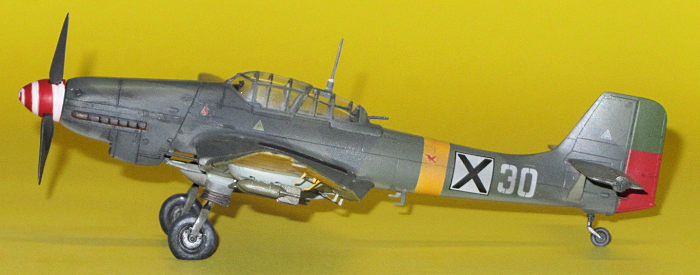 However, Fujimi's
kits gave us all the wartime variants of the Stuka from a common set of molds
and are still unique in that way. Lots of parts in light grey on 4 sprues, one
in clear. Typical of the generation of recessed-panel-line kits coming out of
Japan in the late '80s, this one came out in B, D, G, and R versions in at least
six different boxings, including one under the Testor's label, and features the
modular construction/open-this-hole-
However, Fujimi's
kits gave us all the wartime variants of the Stuka from a common set of molds
and are still unique in that way. Lots of parts in light grey on 4 sprues, one
in clear. Typical of the generation of recessed-panel-line kits coming out of
Japan in the late '80s, this one came out in B, D, G, and R versions in at least
six different boxings, including one under the Testor's label, and features the
modular construction/open-this-hole-
| CONSTRUCTION |
This was actually a refinish project. I had built this kit originally as a "G" with the big gun pods sometime in the '90s, but found out later that I had made some boo-boos in subvariant specifics and paint scheme, plus I really wasn't happy with my over-weathered finishing job and the model had gotten damaged in my many relocations during the years that followed, to boot. But my basic build was sound, and giving old models new life with a little work really satisfies the frugal Midwesterner in me. Plus I've been on a Small Air Forces kick of late.
As I remember it, the initial build was totally straightforward with
no problems. Just remember to read the instructions closely so you open the
right holes before you close things up. I sprinkled a little extra detail into
the cockpit, namely sidewalls and seatbelts, and replaced the so-so cockpit
canopy with a Falcon one which is not only clearer but correctly leaves you
to depict the internal canopy framing with decal strips. O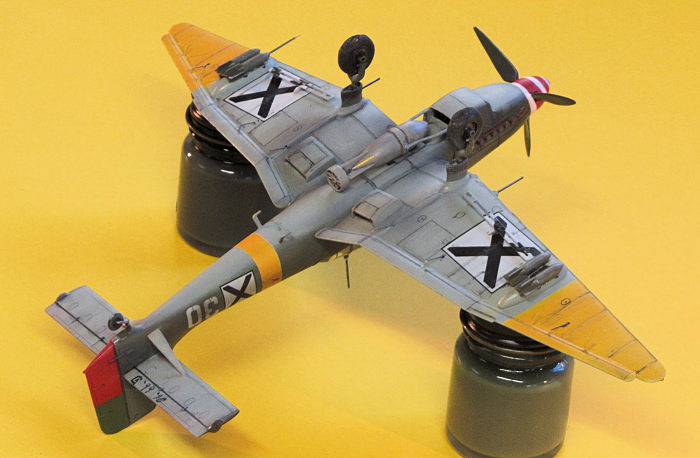 h,
and yes--Fujimi completely missed the pilot's window well between his feet, so
that detail was scratch-built using an unbuilt 1/24 Airfix kit as reference.
Landing gear spats were cut off for the installation of Blackbird Models'
white-metal bare landing gear legs (available at this writing from Blackbird
Productions of the UK).
h,
and yes--Fujimi completely missed the pilot's window well between his feet, so
that detail was scratch-built using an unbuilt 1/24 Airfix kit as reference.
Landing gear spats were cut off for the installation of Blackbird Models'
white-metal bare landing gear legs (available at this writing from Blackbird
Productions of the UK).
The project commenced with slicing off the gun pods and plugging their mounting holes with putty. As backdating the model from a "G" to a "D" would require opening the now-inaccessible holes for the air brakes and outer-wing bomb racks, I purchased another Fujimi Ju-87 online, drilled the desired holes in the lower wing part, and used it as a template to locate (by careful probing with a stiff T-pin) the thinner plastic of the flashed-over holes on the project model, then drilling them out. The old decals were removed by a combination of poking them repeatedly with packing tape, sanding down what remained, and airbrushing over the spots.
The other improvement work involves the following: all variants of the Stuka had lots of doohickeys all over the underside, mainly in the form of mass balances and actuator rods for the control surfaces. Probably for ease of molding, Fujimi depicts the former as simple triangle "fins" and the latter are simply too fragile to survive any handling. As usual, I took the time to replace all of it with metal: the mass balances were fine brass rod with little globs of superglue at the ends, the actuating rods, crew steps, and big comms antenna up top a combination of brass and superglued/sanded styrene strip, and the 20mm wing cannon Albion Alloys steel tube. In the original build, I had used sleeved brass to make the prop removable for finishing and storage. This came in useful when it came time to depict the white-on-red spinner spiral.
I didn't like Fujimi's depiction of the SC50 bombs at all and ended up stealing four from an Italerei Me-210.
| COLORS & MARKINGS |
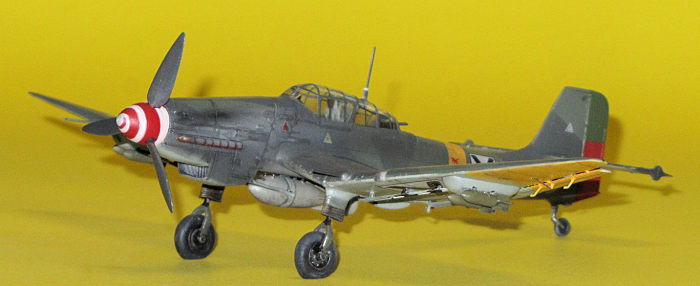 The
Bulgarian Red/Kelly Green rudder flashes were masked and sprayed, and since most
of the Luftwaffe splinter scheme had survived the conversion process it became
the masking guide for a light re-spray. Yellow Eastern Front bands were masked
and sprayed, then the LF Productions' decals went on after a coat of Future.
These performed well and look good, but I think the characteristic Bulgarian
airframe data triangle on the tail is bit small. A light weathering followed,
locked in by a quick shot of clear semigloss.
The
Bulgarian Red/Kelly Green rudder flashes were masked and sprayed, and since most
of the Luftwaffe splinter scheme had survived the conversion process it became
the masking guide for a light re-spray. Yellow Eastern Front bands were masked
and sprayed, then the LF Productions' decals went on after a coat of Future.
These performed well and look good, but I think the characteristic Bulgarian
airframe data triangle on the tail is bit small. A light weathering followed,
locked in by a quick shot of clear semigloss.
| CONCLUSIONS |
| REFERENCES |
26 April 2018
Copyright ModelingMadness.com
If you would like your product reviewed fairly and fairly quickly, please contact the editor or see other details in the Note to Contributors.
Back to the Main Page Back to the Review Index Page Back to the Previews Index Page